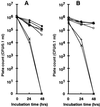Does enterohemorrhagic Escherichia coli O157:H7 enter the viable but nonculturable state in salted salmon roe?
- PMID: 11097946
- PMCID: PMC92500
- DOI: 10.1128/AEM.66.12.5536-5539.2000
Does enterohemorrhagic Escherichia coli O157:H7 enter the viable but nonculturable state in salted salmon roe?
Abstract
An outbreak caused by salted salmon roe contaminated with enterohemorrhagic Escherichia coli O157 occurred in Japan in 1998. Since about 0.75 to 1.5 viable cells were estimated to cause infection, we presumed that O157 might enter the viable but nonculturable (VNC) state in salted salmon roe and consequently that viable cell numbers might be underestimated. Although patient-originating O157 cells could not grow on agar plates after 72 h of incubation in 13% NaCl, they were resuscitated in yeast extract broth, and more than 90% of the cells were shown to be viable by fluorescent staining, suggesting that almost all of them could enter the VNC state in NaCl water. Roe-originating O157 was resistant to NaCl because it could grow on agar after 72 h of incubation in NaCl water, but about 20% of cells appeared to enter the VNC state. Therefore, germfree mice were infected with O157 to examine the resuscitation of cells in the VNC state and the retention of pathogenicity. O157 that originated in roe, but not patients, killed mice and was isolated from the intestine. However, these isolates had become sensitive to NaCl. O157 cells of roe origin incubated in normal media also killed mice and were isolated from the intestine, but they also became transiently NaCl sensitive. We therefore propose that bacterial cells might enter the VNC state under conditions of stress, such as those encountered in vivo or in high salt concentrations, and then revive when those conditions have eased. If so, the VNC state in food is potentially dangerous from a public health viewpoint and may have to be considered at the time of food inspection. Finally, the establishment of a simple recovery system for VNC cells should be established.
Figures


Similar articles
-
Role of in vivo passage on the environmental adaptation of enterohemorrhagic Escherichia coli O157:H7: cross-induction of the viable but nonculturable state by osmotic and oxidative stresses.FEMS Microbiol Lett. 2005 Dec 15;253(2):243-9. doi: 10.1016/j.femsle.2005.09.039. Epub 2005 Oct 10. FEMS Microbiol Lett. 2005. PMID: 16239082
-
Detection of a multi-prefectural E coli O157:H7 outbreak caused by contaminated Ikura-Sushi ingestion.Jpn J Infect Dis. 1999 Apr;52(2):52-3. Jpn J Infect Dis. 1999. PMID: 10816617 No abstract available.
-
[Isolation of Shiga toxin-producing Escherichia coli O157:H7 from processed salmon roe associated with the outbreaks in Japan, 1998, and a molecular typing of the isolates by pulsed-field gel electrophoresis].Kansenshogaku Zasshi. 1999 Jan;73(1):20-4. doi: 10.11150/kansenshogakuzasshi1970.73.20. Kansenshogaku Zasshi. 1999. PMID: 10077898 Japanese.
-
[PulseNet Japan--network system for the utilization of epidemiological information and the results of pulsed-field gel electrophoresis].Nihon Rinsho. 2002 Jun;60(6):1070-6. Nihon Rinsho. 2002. PMID: 12078075 Review. Japanese.
-
Future perspectives, applications and challenges of genomic epidemiology studies for food-borne pathogens: A case study of Enterohemorrhagic Escherichia coli (EHEC) of the O157:H7 serotype.Gut Microbes. 2015;6(3):194-201. doi: 10.4161/19490976.2014.969979. Epub 2014 Sep 1. Gut Microbes. 2015. PMID: 25483335 Free PMC article. Review.
Cited by
-
Multiple factors trigger the formation and resuscitation of the VBNC state in alcohol-producing Klebsiella pneumoniae.Appl Environ Microbiol. 2024 Jul 24;90(7):e0055724. doi: 10.1128/aem.00557-24. Epub 2024 Jul 2. Appl Environ Microbiol. 2024. PMID: 38953658 Free PMC article.
-
Transcriptomic Analysis of Viable but Non-Culturable Escherichia coli O157:H7 Formation Induced by Low Temperature.Microorganisms. 2019 Nov 30;7(12):634. doi: 10.3390/microorganisms7120634. Microorganisms. 2019. PMID: 31801285 Free PMC article.
-
Microarray-based detection of genetic heterogeneity, antimicrobial resistance, and the viable but nonculturable state in human pathogenic Vibrio spp.Proc Natl Acad Sci U S A. 2005 Dec 27;102(52):19109-14. doi: 10.1073/pnas.0505033102. Epub 2005 Dec 14. Proc Natl Acad Sci U S A. 2005. PMID: 16354840 Free PMC article.
-
Viable but nonculturable bacteria: food safety and public health perspective.ISRN Microbiol. 2013 Sep 26;2013:703813. doi: 10.1155/2013/703813. ISRN Microbiol. 2013. PMID: 24191231 Free PMC article. Review.
-
Preharvest Farming Practices Impacting Fresh Produce Safety.Microbiol Spectr. 2018 Apr;6(2):10.1128/microbiolspec.pfs-0022-2018. doi: 10.1128/microbiolspec.PFS-0022-2018. Microbiol Spectr. 2018. PMID: 29676249 Free PMC article. Review.
References
-
- Asai Y, Murase T, Osawa R, Okitsu T, Suzuki R, Sata S, Yamai S, Terajima J, Izumiya H, Tamura K, Watanabe H. Isolation of Shiga toxin-producing Escherichia coli O157:H7 from processed salmon roe associated with the outbreaks in Japan, 1998, and a molecular typing of the isolates by pulsed-field gel electrophoresis. Kansenshogaku Zasshi. 1999;73:20–24. - PubMed
-
- Asakura H, Makino S, Shirahata T, Tsukamoto T, Kurazono H, Ikeda T, Takeshi K. Detection and long-term existence of Shiga toxin (Stx)-producing Escherichia coli in sheep. Microbiol Immunol. 1998;42:683–687. - PubMed
-
- Barcina I, Lebaron P, Vives-Rego J. Survival of allochthonous bacteria in aquatic systems: a biological approach. FEMS Microbiol Ecol. 1997;23:1–9.
-
- Blackburn C W, Curtis L M, Humpheson L, Billon C, McClure P J. Development of thermal inactivation models for Salmonella enteritidis and Escherichia coli O157:H7 with temperature, pH and NaCl as controlling factors. Int J Food Microbiol. 1997;38:31–44. - PubMed
-
- Choa J C, Kim S J. Viable, but non-culturable, state of a green fluorescence protein-tagged environmental isolate of Salmonella typhi in groundwater and pond water. FEMS Microbiol Lett. 1999;170:257–264. - PubMed
Publication types
MeSH terms
Substances
LinkOut - more resources
Full Text Sources

